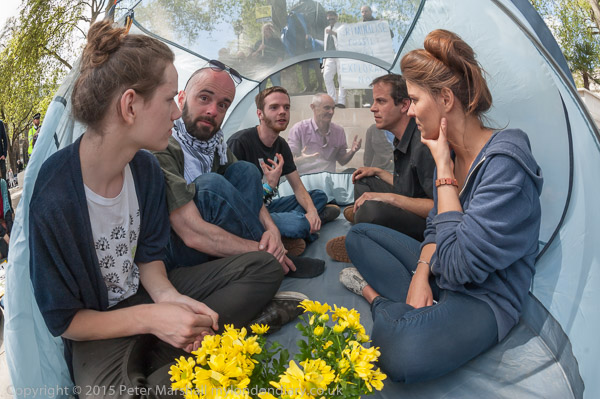
I’ve always felt that London wasted Parliament Square. A world heritage site because of the buildings that surround it – notably the Houses of Parliament, Westminster Abbey, Middlesex Guildhall (now the Supreme Court), the actual square is a large traffic island, with a large area poorly maintained grass and some rather crass temporary flagpoles brought out for state occasions. It has an odd assortment of statues, some rather good, others outstandingly poor.
Over recent years their have been some improvements for public access, which no longer demands a death-defying dash between traffic, with light-controlled crossings at two of its four corners, though the seats which tempted the unwary tourists have now disappeared, presumably because of Westminster Council’s vendetta against homeless rough sleepers.
Perhaps the reason for its curious state is below the surface, where I suspect it houses some secret underground bunker, linked by the mysterious underground passages we know exist between various above-ground government buildings in the area. But it certainly always feels like a missed opportunity to me. If nothing else most if not all of its area should be closed to normal traffic.
But something which I think any seat of government should have in its view is a suitable forum for public dissent, where protesters can make their views felt. Ever since the late Brian Haw took up residence on the pavement opposite the Houses of Parliament back in 2001, Parliament, the GLA, Westminster Council and the police have been doing their worst to stop such things happening or to severely limit them. Perhaps there is a case for some limits, but not for trying to set them so that protest becomes severely inhibited.
Occupy Democracy have carried out a series of protests intended to keep the square as a place for democratic discussion and protest, and I’ve photographed a few of these, though missing the main battles with police and GLA security guards (laughably called ‘Heritage Wardens’) over squares of blue tarpaulin the protesters were sitting (and sometimes sleeping) on, which led to the square being renamed by activists as ‘Tarpaulin Square’.
Recently a court has ruled that it is not a crime to have such tarpaulins in the square, dismissing the case against four people arrested, and leading to a second prosecution being dropped. As often, the police, egged on in this case by over-keen private security, have over-interpreted the law to make it mean what they wanted it to mean.
The court decision was hardly surprising. When Occupy Democracy came to the square last October it was clear to me reading the enforcement notices that the police were exceeding the law, and I told them so, to get the response that they would leave it to the courts to decide. It seemed to be a blatant disregard of the law by those who are paid to enforce it.
Occupy Gandhi – stop fossil fuel criminals on May 4, defied both the ban on tarpaulins and on tents in Parliament Square, though I imagine the protesters will argue in court that the tent was only symbolic and that they had no intention of using it to sleep in.
On this occasion police and GLA Security ignored the blue tarpaulins (except for asking one draped on the statue of Gandhi to be removed), and it was only after a tent had been erected in a deliberate act of civil disobedience that police first warned the protesters and later surrounded it and arrested those inside. You can read more about what happened in My London Diary.
Photographically the event once more proved the value of the 16mm fisheye, with several of the strongest images I made being take with it. It’s a lens that needs some care in use, usually at its best when absolutely upright, and the virtual level markers in the D800E viewfinder proved extremely useful.
The top image on this post is an example where no perspective correction was needed, and the curvature at the edges adds to the image, producing something of a tunnel effect. I liked the near-symmetry of the scene, and the framing through the fabric at the rear of the tent of Donnachadh McCarthy who was leading the protest (he quickly jumped inside the tent as the police arrived to make arrests.)
To make Donnachadh clearer I increased the local clarity and contrast in Lightroom, adjusting the exposure slightly too. The yellow of the flowers is a nice contrast to the blues of the clothing and tent, and the pink shirt also helps Donnachadh stand out. In some other frames I also managed to include the statue of Gandhi, but his head got cut off in this one (at top centre) and it would have been nice to have a little more of the flowers. Sometimes even a fisheye isn’t quite wide enough!
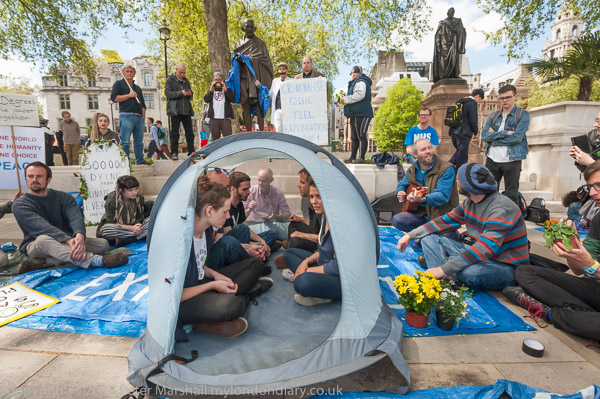
Theoretically I could have moved back a little, but practically that wasn’t possible. I’d quickly moved into position as I saw people going into the tent and worked with the 16-35mm on the D700, then moved away, coming back after the flowers had been put in the tent. After taking a frame with the 16-35mm I changed it for the 16mm fisheye and made a series of five exposures. The people inside the tent were having an animated conversation, and several of those five seemed interesting, but it was when Donnachadh briefly raised his hands that I had the picture I wanted.
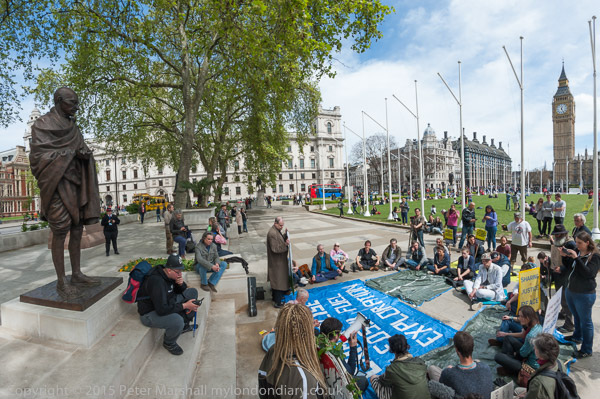
The 16mm fisheye was also the ideal lens to take an overall view of the event, enabling me to work from a close viewpoint and get in both the statue of Gandhi and at the other edge, Big Ben. The horizontal angle of view is around 140 degrees, too wide for a rectilinear lens – which would render both Gandhi and the clock tower as extremely fat. Again I was using the 16mm on the D700, keeping the D800E for the DX format 18-105mm which gives a decent-size file at the 1.5x crop. The D700 lacks the viewfinder level indicators, which accounts for the curved horizon. Correction from fisheye to cylindrical perspective was essential to avoid a curved Big Ben, Gandhi and flag poles.
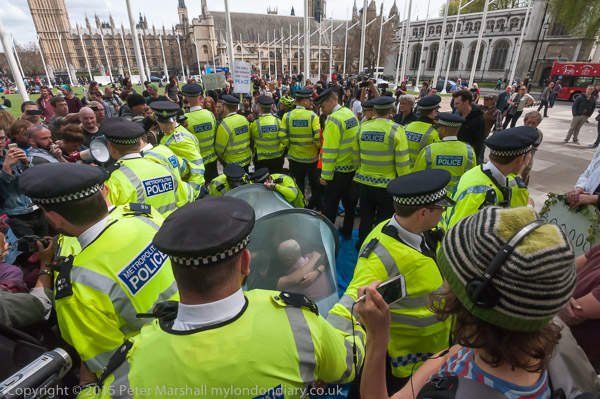
For the surrounding of the tent and the arrests it was fortunate that this took place next to the raised area with the Gandhi statue, giving me a good viewpoint, though the police did rather get in the way, as too did some of the protesters, many of whom were also taking pictures and sometimes holding up phones in front of me. Working with the D700 I did rather wish it had a hinged screen on the back like the Fuji X-T1, so much better when you do have to work with the camera held above your head. For some reason Nikon think this isn’t appropriate in their professional cameras, but I’d find it very useful. As well as the overall views with the 16-35mm, I was also able to take pictures over the shoulders or between the heads of police of the people inside the tent.
Later I went down to ground level and was able to work between the legs of the police surrounding the tent, leaving as Donnachadh was taken away by the police. He struggled as they led him away, then went limp, and was carried by the police to a van at the side of the square.
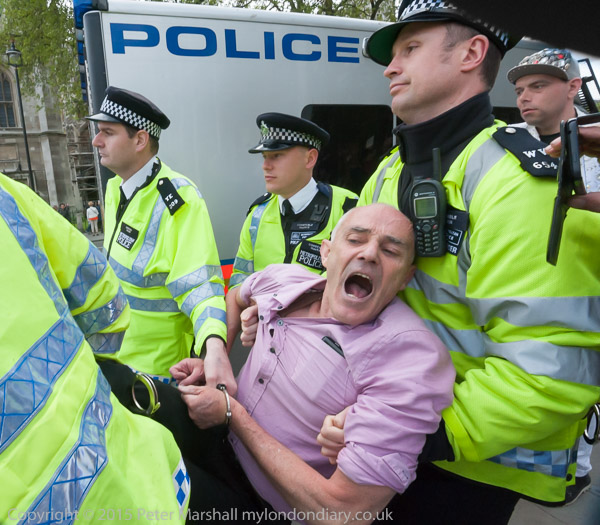
Another inexplicable failure by Nikon is with lens hoods, and in any close situation the lens hood on the 16-35mm will either be knocked completely off (I’ve lost half a dozen that way) or, perhaps even worse, get knocked askew.
This gives vignetting at top left and bottom right corners of the image at wider focal lengths, and is clearly visible in the viewfinder with the lens at 20mm or wider. Unfortunately when things get a little exciting and I’m working flat out I usually fail to notice it unless there is important subject matter in either of those two corners, and I end up with a lot of pictures with dark areas across them. Usually I crop the images to remove them, but often this means losing important subject matter.
The problem is I think a combination of the low profile of the filter mount on the lens with the flimsy flexibility of the Nikon HB-23 lens hood and could probably be more or less solved with a thicker moulding on the hood.
Usually I crop to the normal 1.5:1 format, but in this image I decided to simply cut off the left part of the frame, mainly occupied by more of the police hi-viz jacket. You can see the out of focus lens hood at top right, it’s visual impact removed slightly in Lightroom by desaturating it and the blue fringe it naturally has.
More pictures and an account of the event at:
Occupy Gandhi – stop fossil fuel criminals
______________________________________________________
My London Diary : Buildings of London : River Lea/Lee Valley : London’s Industrial Heritage
All photographs on this and my other sites, unless otherwise stated, are taken by and copyright of Peter Marshall, and are available for reproduction or can be bought as prints.
To order prints or reproduce images
________________________________________________________